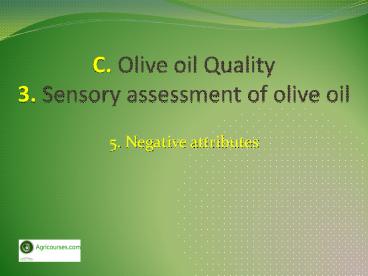Lecture 5: Negative attributes - PowerPoint PPT Presentation
Title:
Lecture 5: Negative attributes
Description:
This course focus on olive oil composition and quality, olive oil categories and types, positive and negative attributes of olive oil, labeling standards of olive oil and quality assurance of olive oil. – PowerPoint PPT presentation
Number of Views:55
Slides: 15
Provided by:
Username withheld or not provided
Category:
How To, Education & Training
Tags:
Title: Lecture 5: Negative attributes
1
C. Olive oil Quality3. Sensory assessment of
olive oil
- 5. Negative attributes
2
Negative attributes
- Low-quality olives
- Olives stored in bad conditions
- Bad procedures during the manufacturing process
- Improper storage of olive oil
3
Undesirable traits part I
- Acetone aroma of nail polish remover, associated
with winey defect - Blue Cheese aroma associated with muddy sediment
defect - Brine salty taste indicating that oil was made
from brined olives
4
Undesirable traits part II
- Bacon smoky essence that may indicate oxidation
- Burnt/Heated caused by processing at too high a
temperature - Cucumber off flavor from prolonged storage,
particularly in tin
5
Undesirable traits part III
- Dirty oils which have absorbed unpleasant odors
and flavors of dirty waste water during milling - Dreggish odor of warm lubricating oil caused by
the poor execution of the decanting process - Esparto refers to straw-like material in mats
occasionally used in older mills that may create
a hemp-like flavor in oil
6
Undesirable traits part IV
- Fiscolo refers to coconut fibers in mats
occasionally used in older mills that may create
a hemp-like flavor in oil - Flat/Bland oils which have no positive or
negative aroma or flavor characteristic of olive
oil may indicate presence of refined olive oil
7
Undesirable traits part V
- Frozen/Wet Wood sweet, dry, and untypical
aroma/flavor derived from olives which have been
exposed to freezing temperatures - Fusty anaerobic fermentation that occurs when
olives are stored in piles too long before
milling
8
Undesirable traits part VI
- Greasy flavor of diesel or gasoline caused by
equipment problems - Grubby flavor imparted to oil by olive fly
damage to olives - Hay-wood flavor of dried olives
9
Undesirable traits part VII
- Muddy Sediment barnyard-like aroma caused by
olives' prolonged contact with dirt before or
after milling - Musty moldy, humid flavor created by wet olives
that have been stored too long before pressing - Metallic oils that have had prolonged contact
with reactive metal surfaces either during
processing or storage
10
Undesirable traits part VIII
- Rancid the flavor of oxidation that occurs as
the oil ages, often described as stale nuts - Rough pasty, thick, greasy mouth feel
11
Undesirable traits part IX
- Sour Milk aroma associated with muddy sediment
defect - Stale Nuts flavor of oxidized oils, rancidity
- Unbalanced oils with overwhelming flavors of
bitterness and pungency
12
Undesirable traits part X
- Vegetable Water oils that have been stored in
contact with the water content of the olive after
processing - Winey sour/vinegary flavor caused by aerobic
fermentation of olives during processing
13
Undesirable traits part XI
- Vinegary sour flavor caused by aerobic
fermentation of olives during processing. - Yeasty aroma of bread dough associated with
winey defect
14
Summary of 5th Lecture
- Negative attributes
- Undesirable traits































